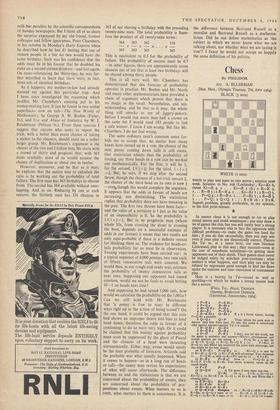Chess By PHILIDOR
207. A. ELLERMAN
(Hon. Men., Olympic Tourney, TEL Avry 1964) BLACK (5 men)
WHITE (7 men) wurrs to play and mate in two moves ; solution next week. Solution to No. zo6 (Loshinsky) ; Kt—Kt 6, threat Kt—B 4. r . . . Kt—B 5 ch ; 2 R—K 5. R—B 5 ; 2 R—B 4. ... Kt—Kt 7 ; ; R—Q 5. . . . P—Q 4 ; R—B 2. r • P—Kt 7 ; 2 R—B 3.
P=Q; 2 QxQ. RxR ch; 2 BXR. Superb problem, greatly preferable, in my opinion, to the first prize-winner.
In master chess it is not enough to try to play sound moves and avoid weaknesses ; you may draw a lot of games like this, but you will rarely beat a strong player. It is necessary also to face the opponent with difficult problems—to make the game too hard for him ; if you do this successfully, then you may win even if your play is not theoretically correct. Players like Tal or, at a lower level, our own Norman Littlewood, play in this way ; they succeed—even at the cost of soundness sometimes—in getting their opponents out of their depth. Their games must never be judged solely by armchair post-mortems • what matters is what happens, and their play can Only be refuted by opponents good enough to find the flaws under the tensions and time restriction of tournament Play.
Here is a brevity by Tal—sound as well as sparkling—in which he makes a strong master look like a novice.
White, TAL. Black, TRINGOV.
Opening, ROBATSCH DEPENC,B.
(Interzonal, Amsterdam, 1964) P P—K 4 P— B— K Kt 3
3 Kt K 4 Kt-14 3B3 Piz-41, B—K Kt.3 Q— t 3 R 4 is a better square, leaving P Kt 4 pOlisible. Q—Q a P Those whom the gods wish to destroy they first drive mad. To take this pawn is notoriously risky agamstan yone—against Tel it is suicide. laKt r 6 8 B 4 R 4 K 3 I don't care for this much, but the game is probably lost anyway—White's development and central position are too strong, 9 P—Q Kt 4 is met by so KrxP, tr B xQ Kt-4 R 3 (1 x , . PxKt?, Is B.—Q 3); anWhite has recovered his pawn with advantage, but ro this aught be the best chance. K R—K r P—(2 ky so . . . Kt—Q 2 is met by rx Kt-11, QxQ; 12 Kt x P ch with advantage. Text threatens ix P t 4; With as KtxP?? met by 12 ._,. R_PxKt. • B— 4 P—K g? Now sz . . . P—Q Kt 4; is B x Q P. P x B; 13 B x Kt. Text move, however, opens up the centre fatally.
• PxP P xp
61 Q • Q— . A Tal move if ever there was one. r7 . . . Kt Or 13 ,..PxB; 14__Kt—Q sl, Kt—Q 2; IS Kt—B 7 ch. K—Q i; 16 Kt x R, and White has a vanningsame. 24 K Kt—Qa • BxPc 1 KxB r6 Kt—Kt S ch K—K z try Q—K 6 ch Reaign r7 . ._._K--Q 12 Kt-137 ch, K---62; 19 1--Q,it mate or 17 . . Kt—K 2; 18 Q—B 7 ch. K—Q ; t— 6 mate, or 17 . K—B I; 18 Q—B 7.rnate.


































 Previous page
Previous page